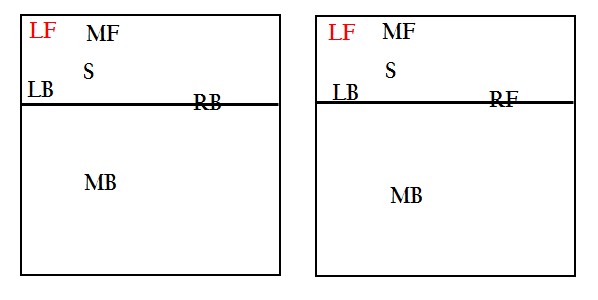I had a reader email asked whether I had any volleyball hitter coverage diagrams for both the 5-1 and 6-2 offensive systems.
My personal philosophy on hitter coverage is that the three players closest to the attacker should be the ones doing the close coverage. The two players furthest away have deep cover. Normally, for a set to the left front attacker hitting in Position 4, that is going to look like the diagrams below. The one on the left is for when the setter is front row. The one on the right is for when the setter is back row. Really, though, they are both pretty much the same.

The above assumes the middle hitter is running a 1st tempo (quick) in front of the setter. Since the middle is already at the net, the setter moves off the net to fill the area between them. The left back then comes in to cover behind the outside hitter (OH). If the middle is running a slower tempo (i.e. a 2 ball), then the setter goes along the net and the middle and setter coverages are reversed. In both cases, the middle back player and the remaining right side player would split the rest of the court between them in deep positions.
The trick comes when the middle runs something behind the setter – especially the slide. In that case, they are likely to be one of the furthest away from the attacker. That means someone else needs to move in to provide close coverage. The right back player is an option, depending on how close they are to the net.
The diagrams below show the ideal coverages for middle and right side attack. In the former case, it’s quite a bit like defense for a middle attack. In the latter case, it looks like a mirror of what is shown above for an attack through Position 4. There’s one catch, though. Because the setter has vacated right back, the middle back player has to get over to provide the third person in close coverage.

All of the above is ideal scenario. Realistically, though, unless you’re playing a relatively slow offense (lots of high sets) you probably won’t see exactly these sorts of configurations happening very often – especially if you have your libero always do close cover. That’s why I said at the beginning the general idea is for the three players closest to the attack – whoever they may be – to find a good position near the hitter and handle the tight cover, leaving the other two for the deeper areas of the court.
The place where this tends to break down most frequently is with whichever attacker ends up in Zone 2. That could be it the right front player or the middle running the side. For whatever reason, they often get lazy about getting into the coverage.
Another tricky situation is on the middle slide. The setter is, as usual, going to turn and follow their set. The right back comes up to cover close behind. That leaves the left front, left back, and middle back players. One of them needs to try to take the short, with the other two staying deep. If there’s a libero on the court, they will likely be the choice. If you run a pipe attack it factors in to things as well, though.
As for back row attacks, generally speaking I like the front row player closest to where the ball will cross the net to be directly under the block. This is especially true at lower levels where the attack power isn’t that great.
2 Responses
Hey John,
Shouldn’t you consider the 5-1 with the MFrunning a slide? In my experience I’ve seen so many teams that do not have any coverage for this attack. Only person close is the RB athlete and maybe the setter.
Good catch Kelly. Added.